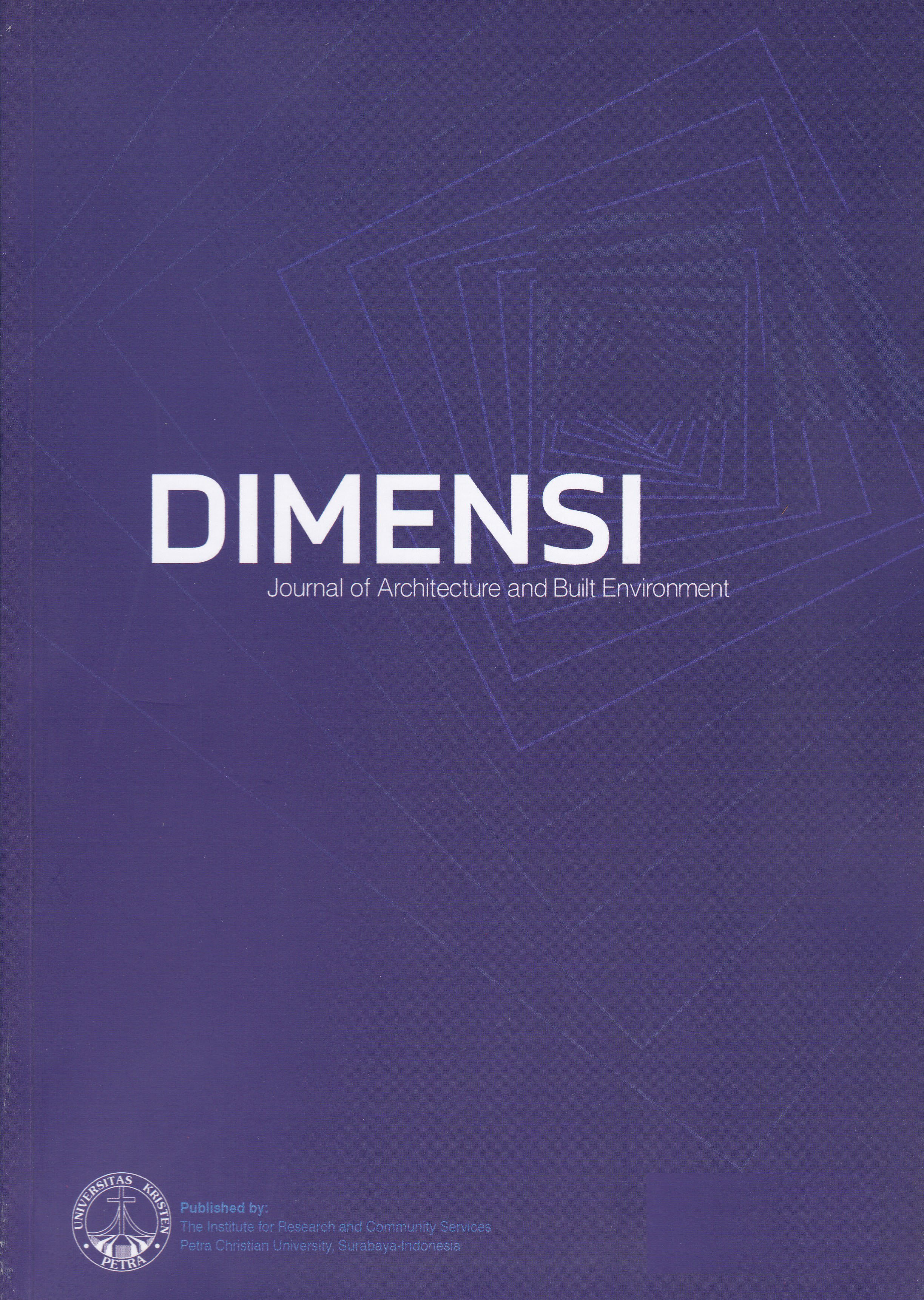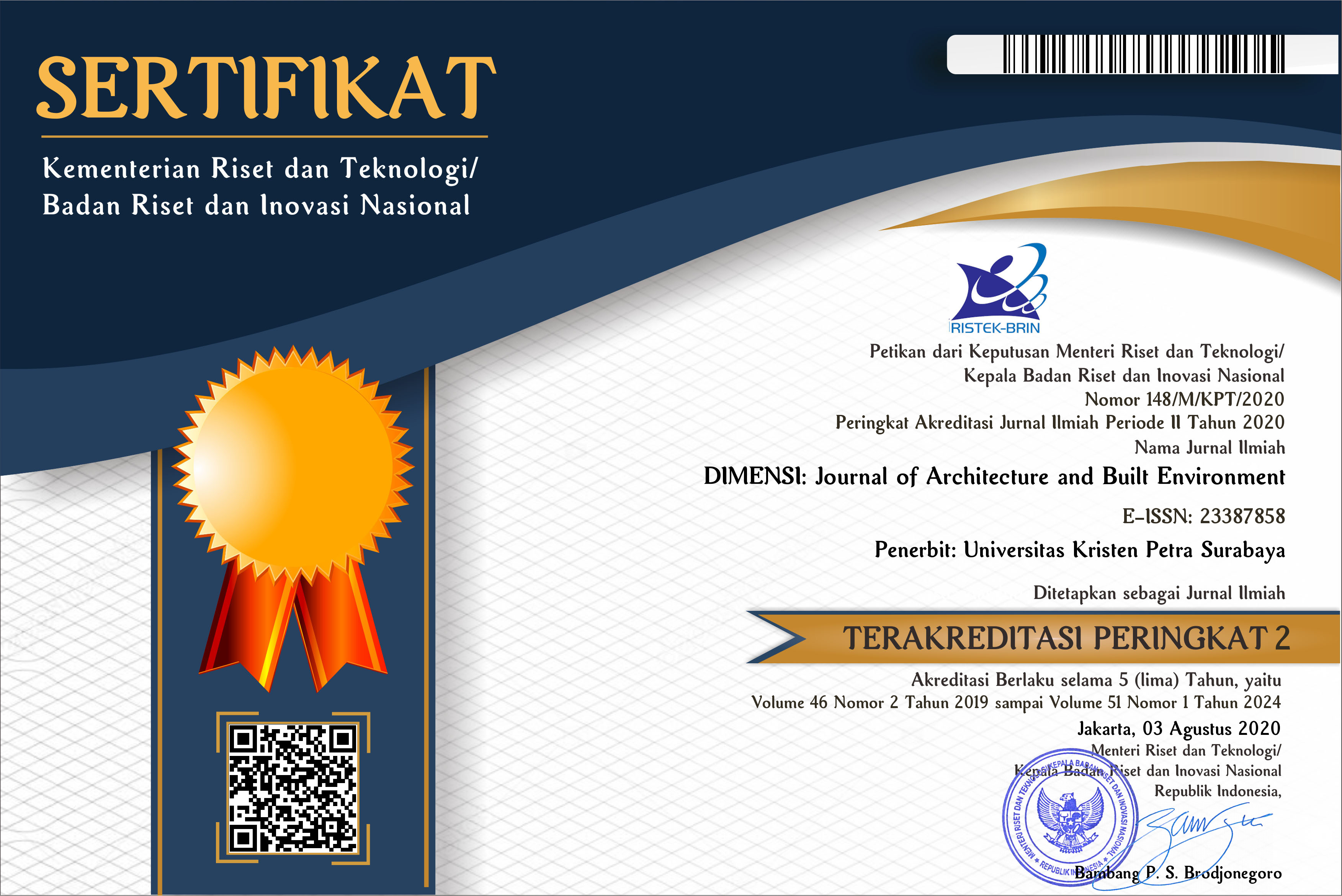ANALYSIS OF ENERGY-EFFICIENT HOUSE LAYOUT DESIGN IN TROPICAL CLIMATE
 :
:
https://doi.org/10.9744/dimensi.47.1.11-18
Keywords:
energy-efficient, building simulation, house layout, cooling loadAbstract
Energy-efficient residential provision is an essential concern for the present and future city development. Currently, the residential buildings contribute approximately 37.5% to significant energy consumption and carbon emissions, which mainly used for cooling. This research aims to study the house layout arrangement to minimise cooling loads and further reduce energy consumption. Energy efficiency analysis is performed by comparing the cooling load and total energy consumption from variations of the hypothetical design of detached or semi-detached housing layouts commonly built in Indonesia. The calculation of cooling loads and energy consumption is performed by simulation in Energy Plus 8.4 with Jakarta weather data. The results show that the arrangement of the house layout may reduce the cooling load up to 24%. The total conditioned wall area that varies due to the variations of house layouts are found to affect the cooling loads.Downloads
References
Alalouch, C., Saleh, M. S., & Al-Saadi, S. (2016). Energy-Efficient House in the GCC Region. Procedia - Social and Behavioral Sciences , 216, 736–743.
Ayanlade, A., Esho, O. M., Popoola, K. O., Jeje, O. D., & Orola, B. A. (2019). Thermal condition and heat exposure within buildings: Case study of a tropical city. Case Studies in Thermal Engineering , 14 (April).
Bavaresco, M. V., & Ghisi, E. (2018). Influence of user interaction with internal blinds on the energy efficiency of office buildings. Energy and Buildings , 166, 538–549.
Chua, K. J., Chou, S. K., Yang, W. M., & Yan, J. (2013). Achieving better energy-efficient air conditioning – A review of technologies and strategies. Applied Energy , 104, 87–104.
Gonçalves, J. C., Costa, J. J., & Lopes, A. M. (2019). Analysis of the air infiltration through the doorway of a refrigerated room using different approaches. Applied Thermal Engineering .
Indonesian Ministry of Energy and Mineral Resources. (2019). Indonesia 2050 Pathway Calculator Panduan Pengguna Untuk Sektor Rumah Tangga. Retrieved 2019, from http://calculator2050.esdm.go.id/assets/mini_paper/energy/id/Panduan%20Pengguna%20untuk%20Sektor%20Rumah%20Tangga.pdf
International Energy Agency. (2018). Key World Energy Statistics.
Jesha, T. A., & Iqbal, M. T. (2015). Thermal simulation and energy consumption analysis of two houses in St. John’s, Newfoundland. Procedia Engineering , 105, 607–612.
Jim, C. Y. (2014). Air-conditioning energy consumption due to green roofs with different building thermal insulation. Applied Energy , 128, 49–59.
Koroneos, C., & Kottas, G. (2007). Energy consumption modeling analysis and environmental impact assessment of model house in Thessaloniki-Greece. Building and Environment , 42 (1), 122–138.
Mechanical Engineering. (2017). Retrieved from https://www.mechlectures.com/tag/components-of-cooling-load/
Praznik, M., Butala, V., & Zbašnik Senegačnik, M. (2013). Simplified evaluation method for energy efficiency in single-family houses using key quality parameters. Energy and Buildings .
Shabunko, V., Lim, C. M., & Mathew, S. (2018). Energy & Buildings EnergyPlus models for the benchmarking of residential buildings in Brunei Darussalam. Energy & Buildings , 169, 507–516.
Shi, Y., & Li, X. (2018). A study on variation laws of infiltration rate with mechanical ventilation rate in a room. Building and Environment .
Wang, W., Rivard, H., & Zmeureanu, R. (2006). Floor shape optimization for green building design. Advanced Engineering Informatics .
Wong, N. H., & Li, S. (2007). A study of the effectiveness of passive climate control in naturally ventilated residential buildings in Singapore. Building and Environment , 42 (3), 1395–1405.
Yu, C., Du, J., & Pan, W. (2019). Improving accuracy in building energy simulation via evaluating occupant behaviors: a case study in Hong Kong. Energy and Buildings , 19.
Yun, G. Y., & Steemers, K. (2011). Behavioural, physical and socio-economic factors in household cooling energy consumption. Applied Energy , 88, 2191-2200
Downloads
Published
How to Cite
Issue
Section
License
Authors who publish with this journal agree to the following terms:
- Authors retain copyright and grant the journal right of first publication with the work simultaneously licensed under a Creative Commons Attribution License that allows others to share the work with an acknowledgement of the work's authorship and initial publication in this journal.
- Authors are able to enter into separate, additional contractual arrangements for the non-exclusive distribution of the journal's published version of the work (e.g., post it to an institutional repository or publish it in a book), with an acknowledgement of its initial publication in this journal.
- Authors are permitted and encouraged to post their work online (e.g., in institutional repositories or on their website) prior to and during the submission process, as it can lead to productive exchanges, as well as earlier and greater citation of published work (See The Effect of Open Access).



















